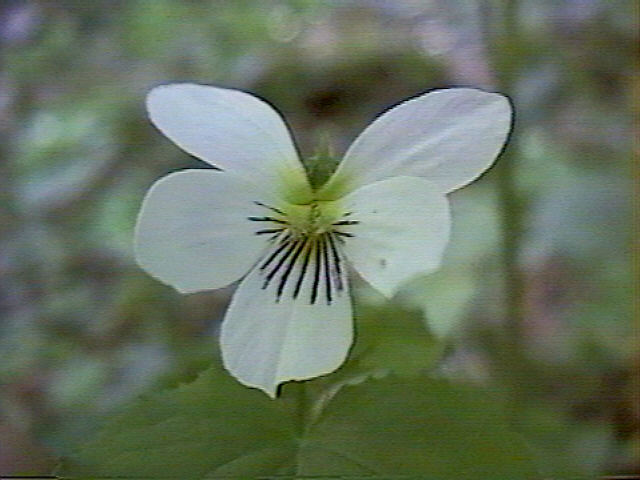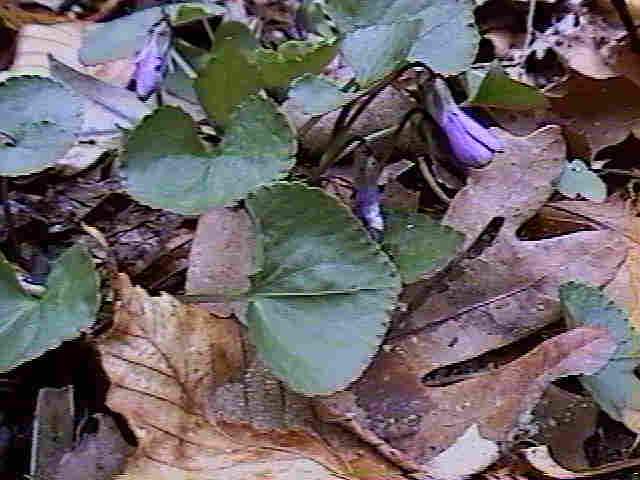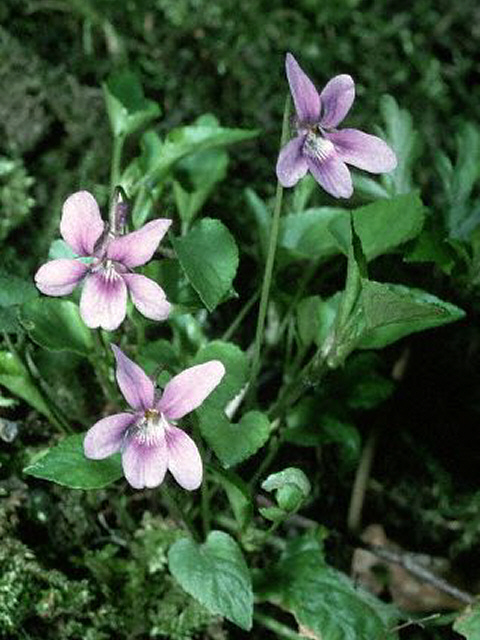" 'I never saw anybody that looked stupider', a
Violet said, so suddenly, that Alice quite
jumped..."In looking Glass, Lewis Carroll attributes
to this flower a far more caustic tongue than I would have
expected after looking closely at their faces.
Now, and I don't know how it's happened, violas and
pansies have appeared like a deep indigo dye soaking
through the pages of this book. Ought I to apologize
because there they come again? Perhaps it's because the
flowers are universally available with their familiar demeanor,
and maybe too because they are found in natural habitats
as diverse as the blandly pastoral and the raw
wilderness.
They are flowers to which there has to be some sort of
response, however dedicated to the smell of diesel oil
and the thrum of machinery a person indifferent to flora
and fauna may be. As there are about twenty-two genera
and well over nine hundred species of Violaceae
worldwide, it's not surprising that we make strong and
personal judgment about these flowers. I know I have
written about violets, violas, and pansies earlier in
the book, including those aberrations, those nightmare
mutations bred for show with faces and purple patches
too heavy to remain vertical without support, but now I
want to write about the species of this genus: the
source of all the hybrids we buy by the fistful each
spring and autumn.
Violets have been with us for thousands of years, and
but for them, and for their continuing existence, we
would never have the annual treat of stocking our
flowerbeds from seeds and nurseries with members of this
motley clan just as demurely or as flamboyantly as we
choose. Lose the wild flowers, and we would lose our
source of renewal.

|
|
Viola Canadensis
|
In America, at the end of the last century, New England
was the Mecca of violet growing, and, as in London,
violets were sold on the streets of New York. Natives of
the violet family, such as Viola blanda,
are still to be found in the United States from Maine to
Georgia. V. canadensis is an herb of the
eastern seaboard and the Rockies, while a tall, striped
viola, V. striata, and the large-bloomed
Great American Violet, V. cucullata, are
found in the far north of the continent.
In the Olympic National Park in the state of Washington
are found three of the most lovely violas: the hook
violet, the pioneer violet, and the Flett Violet.

|
|
Hook Violet (Viola adunca)
|
The hook violet, V. adunca, a low,
deep blue flower with a white heart, and the tall pioneer
violet, V. glabella, a brilliant
yellow flower with heart-shaped leaves and purple
"honey guides," both grow in the impenetrable
forest, where openings of the tree canopy allow enough
sunlight through, and also in the sub-alpine zone
(similar to the sub-artic regions of Canada), where the
growing season is short and where, in midsummer, there
are moist meadows and dry hillsides. The hook violet is
also widespread in the temperate parts of North America
and the pioneer violet is found in southern Alaska and
the Sierra Nevada.
The third of these violas is rare: the Flett violet,
V. flettii, is bluish-purple and only
appears in the high country after the last snow has
melted among rocky crevices of the peaks on the south
and west-facing slopes. The Flett violet is among seven
other plants endemic to the Pleistocene Ice Age.
Glaciers, about three thousand feet deep, left isolated
peaks rising above frozen desolation, and where these
eight relics have miraculously survived.
The violet family are promiscuous; given the chance,
they would inveigle us to sigh over their frailty
throughout north European countries and Greenland, the
Mediterranean, Asia Minor, the Caucasus, Syria,
Palestine, and North Africa; on through Kashmir, the
Atlas mountains, and the Himalayas, to Central Siberia
and the Altai mountains; and improbable as it may seem
the marsh violet inhabits the Azores.
For the following information on the thirteen species
indigenous to Britain I am unequivocally indebted to a
friend and botanist, Jo Dunn. Without her painstaking
field work and research as well as her scholarly notes,
photographs, and patient guidance, I should be wallowing
in a sea of violets, unable to disentangle one tiny
flower from another.

|
|
Early Dog Violet |
Here are their Latin names for those in the know or on
the brink of becoming that way: Viola odorata
(sweet violet); V. hirta (hairy violet); V.
rupestris (Teesdale violet); V. riviniana
(common dog-violet); V. reichenbachiana
(early dog-violet); V. canina (heath
dog-violet); V. lactea (pale dog-violet); V.
persicifolia (fen violet); V. palustris
(marsh violet); V. lutea (mountain pansy);
V. tricolor (wild pansy but also known as
heartsease); V. tricolor subspecies curtisii
(dune pansy): V. arvensis (field pansy)'
and V. kitaibeliana (dwarf pansy).
Starting with the sweet violet, this one appears
early in the year with a span of colour varying from
deep purple, through lilac and rosy-mauve to white and
it's the only one of our violets that is scented. How
surprising when you think now often we associate these
flowers with fragrance. The sweet violet lurks; scrub,
hedgerows, or woodland are its territory as well as
chalky soil. IN country churchyards where it may occur
naturally or may have been deliberately introduced from
gardens or countryside, it remains safe from
annihilation by the manic use of herbicides which still
pollutes even some of our graveyards. As summer
progresses reproduction of the sweet violet is either by
self-pollination or by means of "stolons," the
surface runners, rather as strawberries take root.
The scentless hairy violet in shades of shadowy
blue-violet veined with purple, is as beautiful as any
in this country. Found in open, calcareous grassland it
is clumpy in growth with a creamy eye and leaves that
when young scroll inwards the way some shells are
devised. The hairiness comes from the roughness of the
leaves and dense hairs on the leaf-stalks, which make it
easy to distinguish from the sweet violet. Instead of
runners, it has seeds and seed-stalks rich in oil. Jo
tells me she has found young seed-coats lying in little
heaps around these flowers: the work of that nocturnal
and big-eared creature, the wood mouse, which has an
appetite for juicy fruit and buds, peas and beans, as
well, apparently, as for the hairy violet. As for ants,
a kind of symbiosis has arisen between them and the
violets' because they relish the oily seed-stalks, the
ants carry the seeds away, dispersing them among
anthills where the plants grow with abundance. Although
widespread in Britain, the hairy violet has become so
rare in the Burren, County Clare, Ireland, that it is
now a protected species.
The third of these native flowers is exquisite. The Teesdale
violet is minute: a tufted non-creeper, hairy all
over, it is described as an upland plant and rare in
Britain but fortunately it is distributed throughout
central Europe including parts of Norway, Corsica, the
Italian Alps, Macedonia and Central Asia; in North
America from Quebec to Alaska and south from Maine and
Oregon. And according to the Red Data Book: "This
perennial is known from eleven localities on open,
mossy, sheep-grazed turf or bare ground on limestone in
Yorkshire, Durham and Westmoreland...Though it appears
to be adequately protected now, threats exist from
collectors, because of its rarity and the proximity of
an easy access road in one area, and from the planting
of conifers." (That dread habit we have in Britain
of spreading sterility up and down our hills).
Anyone walking country lanes will have seen the common
dog-violet, a bluish-violet perennial with a paler
spur, concealed on banks or among last year's woodland
leaves. It flowers later than the sweet violet and the
early dog-violet and, as far as I'm concerned, all three
appear impossible to distinguish. But for those in the
know, with sharp eyes and the inbuilt habit of looking
where they walk, this trio, unless they've hybridized
from close proximity, can be sorted out by the shape and
colour of the spurs, whether they have runners (which
this one hasn't) and from the form of leaves, sepals and
stipules.
The fifth in this list is the early dog-violet,
another non-creeper distinguished from the common violet
by having paler, "fly-away" petals giving it
an alert, listening look. And whereas in the common
dog-violet the spur is cream tinged with violet, here
the spur is darker than the petals. In England it's
everywhere: hedgebanks and woods, on limy or chalky
soils, but curiously it is only sprinkled about Wales
and Ireland and rare in Scotland.
The heath dog-violet, with short creeping
rhizomes, is a very blue species with a yellowish spur,
found growing in acid grassland, fens or on heaths.
The seventh flower is enchanting. Milky-coloured and
ghostly, this noncommittal pale dog-violet has
leaves often tinged with purple, adding to its unearthly
quality. Growing in scattered localities on dry heaths
in Anglesey and Pembroke, Sussex, Essex and often in
southwest England, the flower is also found in parts of
Ireland. On the Gower peninsula in south Wales Jo Dunn
hunted it down on cliff-tops, surprised to find it
growing so close to the sea.
The fen violet, V. persicifolia
(which descriptively means "with leaves like those
of the peach tree" and was called persica
malus by Pliny), is a beautiful flower a breath
away from vanishing. Rare! Endangered! Vulnerable! What
other adjectives carry such dire forebodings? The
flower, looking as frail as its tenuous fingerhold on
life, with hairline veins on the underside of its
duck-egg blue petals, a pure white throat, a greenish
spur and notched leaves, blooms in May and June in the
fens of Cambridgeshire, Huntingdonshire, and among damp
grassy hollows on the limestone of western Ireland from
Fermanagh to Clare. Hounded from the fens by drainage,
chivvied into its one remaining habitat on newly
disturbed peat in Huntingdonshire, the fen violet has
triumphantly reappeared, after sixty years' absence,
among the peat diggins of Cambridgeshire. And in
Ireland, because it grows near the turloughs - those
strange lakes with fluctuating water levels that lie
among limestone rocks - it's known as the turlough
violet. Thankfully in other parts of the world this
endearing little creeping herb still exists.
The marsh violet has a delicate face. Pale lilac
with darker honey guides spread across the petals like a
delta, the plant lives up to its squelchy name by
perpetuating itself with creeping rhizomes in bogs,
marshes, fens and wet heaths.
The next five are pansies. It is impossible not
to gush over their expressive faces.
"Adorable" sounds sickening, but that is how
they look. Each is a winning as the last. Enjoyment,
surprise, alertness, reticence or self-deprecation -
they reveal it all.
Though the plants are small --some often skulk among
leaves or tufty grasses- differences in appearance and
habit make it easy to distinguish the wild pansy from
the violets. The latter, which must painstakingly be
searched for are synonymous with modesty, shyness and
all those fairly low-key attributes that have long been
associated with this flower. And while two of the
pansies may be said to possess such qualities, the other
three (including a subspecies)--the mountain, wild and
dune pansies--though they could never be called
immodest, are relatively bolder. As their names suggest,
they go in for a more open lifestyle. Although they
share with the violet nectar-filled spurs and radiating
honey guides on their petals, pansy flowers differ in
having flat, more rounded faces which, in most cases,
are larger and more vividly coloured; and while pansy
leaves aren't dissimilar from those of violets, their
stipules are distinctive, being leaflike and deeply
lobed.
If appearance were all, then you only need to look at
the beautiful, enquiring face of a bright yellow or
violet-coloured mountain pansy to realize that
this is where demureness all but vanishes and a hint of
showiness begins. No wonder the cultivation of many
strains of our garden pansies started here.
The mountain pansy is bright yellow but
occasionally, to baffle you, the flat flowers may be
purple or blotched, arbitrarily lined with honey guides
on its naive and cheerful face. The flower grows in
upland, often calcium-deficient grassland, and on rocky
ledges in every country north of a line between the
Humber and the Severn.
Some modern garden pansies have evolved from hybrids
between this one and heartsease. According to which way
you face, show and fancy pansies have been its ultimate
fate or triumph.
Now we come to heartsease whose name ought to shower us
with blessings. The wild pansy, V. tricolor,
appears everywhere there are recording enthusiasts, in
the garden or in the wild: "It groweth often among
the corne," wrote William Turner in 1548. And it
still does. Deep purple, light mauve, yellow or
combinations of these, this flower seeks acid, light or
sandy waste ground, rarely in the south and then only on
mountains. Judging by the long list of local names with
love and kiss in them, this plant provokes particularly
endearing associations. To name a few: Love-in-Idleness,
Leap-up-and-Kiss-Me and Kiss-me-Love-at-the-Garden-Gate
speak of a rural idyll well suited to a retiring flower
known as heartsease. Oberon, in A Midsummer Night's
Dream, squeezed the juice from Love-in-Idleness into
the eye of Titania so that on waking she would fall in
love with Bottom. Why it should have so many love names
is not clear, but in contrast to this jolly wantonness
the herb also has a pious image: thought by some to have
the appearance of three faces under a hood, it is also
known as "Trinitatis herba" --the Blessed
Trinity flower.
Among the monumental range of research undertaken by
Darwin during his long lifetime (which included a study
of the life cycle of earthworms), he studied the way
transplanted heartsease so instantly changed colour and
markings, and yet could return to their original colours
before the end of the summer. Such capriciousness was a
bane and a boon. In the wild, in different soil and
climatic conditions, identifying Viola species could
become very hit-and-miss. On the other hand heartsease,
with agreeable facility, could breed a whole chiaroscuro
of offspring. The violet family are apt to lose their
head when it comes to procreation, and crossbreed
avidly, which accounts for the numerous progeny of
pretty hybrids that turn up in our gardens, their
parentage unrecorded until it is too late for the
botanist intent on nomenclature. Even in the gardens of
Buckingham Palace, Dr. David Bellamy has discovered
three vagrants: the common dog-violet, the field pansy,
and, let's hope it works, heartsease.
The dune pansy (V. Subsp. Curtisii),
is almost like a small mountain pansy. Yellow,
blue-violet or parti-coloured, this perennial has
flowers with such stand up petals it has a prick-eared
expression which is most appealing. By adapting to
inhospitable terrain it grows in dunes and grassy places
close to the sea in parts of Britain, as well as the
chilly shores of the Baltic.
The twelfth and most self-effacing of the lot is the field
pansy. Usually a yellow as pale as clotted cream,
this annual is commonly found on cultivated or waste
ground in Europe or as remotely far flung as in Siberia,
Iran, Iraq, and North Africa. "This is one of the
arable 'weeds' which has resisted elimination by modern
herbicides," says Jo Dunn. "When the capsules
explode, the seeds may be spread as far as two metres."
Luckily, these tactics help to ensure that the plant
survives But only those partial to bending over as they
walk the countryside would have the engrossed patience
to notice the flower as Jo does. As she succinctly
remarks: "It's a small, rather overlooked pansy,
which needs to have a hand-lens focused on its face
before it can be appreciated!"
The last of the tribe is the dwarf pansy: a very
rare annual with a hooded cream or pale violet face, its
flower is minute, sometimes no more than 1 inch in
height, but it has great charm. Jo Dunn admits she has
only seen this pansy once, by crawling on hands and
knees with a lens at the ready: "I marvelled that
anything so small could survive!" according to the
ominous and somewhat puzzling words of the Red Data
Book, it "will be endangered only if digging for
sand ceases and rabbits become extinct." For unlike
so many wild and garden plants - it thrives on
disturbance.
Whether grown from seed or by division the full range of
violaceae for the garden means you have your hands on an
infinity of variations. The colour range is past
defining; so many of the species of Viola from all over
the world, not just the thirteen I've listed here, have
produced superb cultivars.